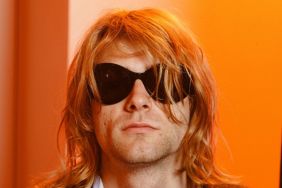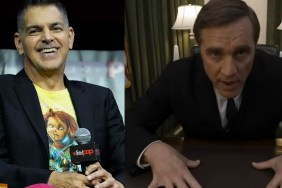
Morgen is probably best known for his 2002 doc The Kid Stays in the Picture, a portrait of Hollywood producer Bob Evans that helped redefine visually what could be done within the documentary format, and he’s used similar techniques in Montage of Heck to bring Kurt Cobain’s private never-before-seen notebooks full of writing and art to life. Add to that some rare home movies made of Kurt and Courtney Love in the years before his death and the first-ever on-camera interviews with Kurt’s mother, father and sister, the people who knew Kurt for longer than anyone else, and you have a film with unprecedented access into the mind of the artist who was taken from this world far too soon while still at the height of his fame.
ComingSoon.net got on the phone with Morgen last week to talk about how the doc came about and were surprised to learn he remembered the last time we spoke in 2007 when he was already hard at work on Montage of Heck and telling us how it was going to be different from A.J. Schnack’s Kurt Cobain: About a Son. Turns out that in that interview he perfectly described how the planned movie would turn out.
ComingSoon.net: Hey Brett, how are you doing? I guess we haven’t spoken in a while, I guess not since “Chicago 10,” which was a long time ago.
Brett Morgen: Well, I’ve been busy. But the funny thing is, man, if I remember, and I may be mistaken, I have a vague memory of talking to you about this film back then.
CS: It’s definitely possible, because I kind of remember that. I was thinking, “Wait a second. Is this the movie he was telling me about back then?” I guess it must have been, because that was seven or eight years ago.
Morgen: Yeah, because when I was out doing press on “Chicago 10,” I thought this was about to go at any minute, so yeah, it’s been eight years, but in a way, it just feels like yesterday.
CS: So what actually started you on this? Did Courtney or Frances approach you or was this something you were interested in and went after?
Morgen: No, I was approached by Courtney in 2007. She had seen “The Kid Stays in the Picture” and was a big fan of the way we used photo animation for the movie, and she said to me, “The realm of Kurt as the frontman for Nirvana, but he was really an artist who was constantly creating, and I have all this art in a storage facility that I think can be the foundation for a film.” And so, that set me on this five-year journey of acquiring all the rights that would be necessary to make the film.
CS: Courtney’s kind of notorious for not allowing anything to be used by anyone pretty much and has been for many years. Do you have any idea why all of a sudden she decides, “Okay, we have to get this stuff out there?” Obviously, there’s a lot of private stuff, the work, the home films and everything.
Morgen: That’s the million-dollar question, man. I asked her that on stage at Tribeca. I feel like the time is just right and she had nothing to lose. She had told me she had watched “The Kid Stays in the Picture” every day for three months. We have a couple of mutual friends, Brett Ratner and Bennett Miller. I remember right after she told me–because I had heard the rumors and the stories about Courtney–so I called Bennett, and he spoke really highly of her, but that said, it became clear pretty quickly that while she was the progenitor of the project, she couldn’t have any control over the project. That was something she never fought over. She never fought me, she never pushed back on. It’s weirdly… sometimes I’m not sure, other than saying she had nothing left to lose, but I also kind of think that she thought I was a bigger filmmaker than I am. She had so much respect for me as a director. It was kind of strange, because she really gave me the greatest gift that you can instill upon a filmmaker, which is trust and respect and that’s what happened.

Morgen: Listen, I feel like one of the questions I had when I was first approached about this film was, “Is there anything left to say about Kurt?” I think I was as cynical as most people. Hasn’t there been enough written about him or movies about him? But what became clear is that there are all these books and there were all these movies, but the one thing they all were missing was the one thing that draws us all to Kurt, which is his art and his music. Having listened to every interview with Kurt, including Azerrad’s entire 25-hour interview, I found that Kurt–of all the forms of expression that he communicated in–the one area that was probably his weakest were the interviews. As I started to unearth all of these primary sources in the storage facility, the man that started to emerge had a different voice than I was hearing in these interviews. It became evident that in order to tell the Kurt Cobain story, I couldn’t rely on his media interviews or build it around interviews with friends and associates, but I had to allow him to tell the story through his art. That became the challenge of the film. How do you do a movie about a man’s interior journey through life? But with Kurt Cobain, we had a unique opportunity in the sense that Kurt was such a prolific artist and expressed himself so vividly in so many different forms of media and expression, both orally and visually. He wasn’t just a musician, he was a sound designer, and did collages, audio collages, and film score, if you will. Visually, he created Super 8 films and took a bunch of 35-millimeter photography and made all these wonderful paintings and sculptures. It wasn’t that his art and his visual art was as technically-advanced as the great visual artists of our times, but it took the same elements that make his music so accessible and honest, which is his passion. So, in a way, we had an opportunity to allow Kurt…. in a way, Kurt kind of created an oral and visual autobiography of his life. So, the question that I originally had, “Is there anything left to say? By the time I was done, the answer was clear: “Yes, everything.”
CS: It’s interesting that in that interview we did seven years ago, you pretty much described this movie and eight years later, it’s exactly the movie you set out to make, but it’s a different approach some might expect as you have mixed media and a lot of different elements. You do have interviews with people who knew Kurt, but they’re spaced out and aren’t a lot, so it never becomes a talking heads movie.
Morgen: No, and that was not anything I’d anticipated, you know? What happened was, as a result, whatever context I needed to provide for his art, I figured I would get from him through his own interviews, right? So, it’d be Kurt filling in the holes, if you will, or helping to contextualize things. But, as I said, I didn’t really respond to his interviews, to the voice. At that point, I felt kind of, it was the first time in my career, where I was at a total loss, and that I was deep into it at that point. I remember being a bit frightened. I called my line producer and I said, “How much have we spent so far?” Because at that point, I wanted to give the money back to the studio. This is after six years, you know? I just didn’t feel I had what I needed, because I’m so reluctant to do talking head interviews. It’s just something I try to avoid. Then, finally, I said, “All right, I’m going to interview the five people who were closest to Kurt in his lifetime.” It was because of Frances Cobain that they all agreed to participate, so in “Montage of Heck,” we hear from his mother, father, and sister for the first time on camera, which is also in and of itself, remarkable, that it took 25 years for that to happen. You know, I was really inspired. I don’t know if you remember this. I know you saw “Chicago 10.” There were some scenes in “Chicago 10” of Abby Hoffman doing standup. It was like black and white animation. Those were a direct homage to the movie “Lenny,” which continues to inspire me throughout my career, because when it came down to doing the interviews for “Montage of Heck,” I went right back to the well and watched “Lenny” and fell in love with the way the interviews are presented in that film because they’re very primal and intimate. It’s used sparingly. If you remember, it’s the mom, the girlfriend, and the manager. It feels like they’re all taking place over the course of a long day. That was kind of how we structured the interviews in “Montage of Heck.” It starts off in morning light at Wendy Cobain’s house and ends in deep shadows with Courtney Love and deep into the evening. So, there’s also that sense of sort of people being sort of hunted, in a way. I felt like, and maybe this is something to do with suicide and that thing that there’s no resolve, if you will. It’s hard to come to some sort of resolution. I certainly felt that everybody I communicated it with was still in so much pain. I mean, you could see it particularly on Don Cobain and those expressions and the way he grips the sofa and all of his mannerisms and his cadence.
CS: I want to ask about the “Montage of Heck” composition where you got the film’s title film. I don’t think anyone knew that piece existed and then it just came from out of the woodwork sometime last year or before. How was something like that hidden for so long and how did it leak, presumably while you were finishing up this movie?
Morgen: This is actually a great story. When I was in the storage facility, we discovered a box with 108 cassettes, which added up to over 200 hours of unheard Cobain audio, of all varieties. There were mix tapes and there were rehearsals and there were endless hours of Kurt and Courtney sort of jamming and sound effects and design elements and all sorts of wonderful stuff, and you know, unheard songs and all this stuff. One of the tapes I discovered was a tape called “Montage of Heck.” I vividly remember putting it on and I was in this room surrounded by all of Kurt’s art and material possessions. It was a wonderful way to discover “Montage of Heck,” because I had no idea what was going to be on it. I’m listening to this thing, and I just felt, “Here I am surrounded by all this art, and yet, this tape is, in a way, the most pure expression of Kurt.” It’s almost like a portal into his mind and it’s almost like a blueprint for how to make this film. At that point, I decided I wanted to call the film “Montage of Heck.” Well, that was not met with a lot of applause from the Universal Pictures. They felt that the film was going to go out all over the world and that that title doesn’t translate. It wouldn’t mean anything to anyone. I understood where they were coming from. That was a hard one to fight for. I tried to say, “Well, among hardcore afficianados, they are aware of this tape, and what have you.” So they said, “Listen, you’ve got to come up with a different title. We want a song title and a song name in the title.” So, after much consideration, I landed on “Breed.” If there was one song title that sort of encompassed the themes of the movie, that seemed to be the most relevant.

CS: So it ended up working out pretty well, then, okay.
Morgen: Yeah, and I would chalk that up to divine intervention, man, because how in the world does that even make sense? You know? It’s just illogical.
CS: I have to assume that Kurt made a copy for one of his friends or something.
Morgen: Oh no, obviously someone had got a hold of it back in the day, because Kurt would pass the tape around, you know? It was a gift he would give to his buddies.
CS: I want to ask about the home movies with him and Courtney because they’re probably the most surprising thing. They’re actually kind of disturbing at times. I’m surprised that Courtney would let them be seen by anyone, but you also have a lot of them. I was curious about your decision to include them in the movie and what you wanted them to bring to the movie?
Morgen: Well, Courtney had never seen a bunch of those videos. The main source with the tape that was shot before Frances was born between Kurt and Courtney during the time that they were on retreat. That tape, I didn’t receive that tape from Courtney. I received it from one of her friends, who called us up and said, “I have this High-8 tape. I’m not sure what’s on it. Can you get a deck and there may be some Kurt and Courtney footage on it?” And he came over, and we put it on and there was probably some of the most revealing and insightful footage of their relationship, that certainly that I’d ever experienced. It was sort of like the missing piece. But I think you’re referring to the more sort of harrowing material of later in the film with them on heroine, with Kurt clearly doped, trying to give Frances a haircut. I thought that was an important element to the story, because without it, we would’ve been left with a slightly romantic image of Kurt. It’s a type of sequence that you never really see in these type of films, because generally someone doesn’t want that to get out there. I felt that if you’re doing a film about Michael Jackson, then you sell fantasy, but if you’re doing a film about Kurt Cobain, it should be honest. People have such a personal relationship to Kurt, that fans who’ve never met him feel protective over him. I felt that the question of what should or shouldn’t be seen really isn’t something that belonged to me, it belonged to his next of kin, and that was Frances. Frances is the one who dictated to me, was to make this film honest. You know, I hate that material. It makes me sick. But it’s important because in that scene, you see the circle. You see the love that he has for his daughter, and you see at the same time, how he’s losing the battle with his addiction.
CS: I actually do like the scenes with him with Frances, when she’s still a baby. If I was able to find video of my father with me as a baby, I’d be completely over the moon. It just doesn’t happen. We can’t find that stuff. So it’s amazing.
Morgen: Yeah, and all that stuff, I mean, Frances has not seen any of this material. This is all sort of revelatory, but like I said, I felt that I find that the intimacy of this film isn’t necessarily from those videos, but from Kurt’s expressions in his art and in his journals. I find the most intimate moment of the film for me personally is the sequence in Tracy Miranda’s house, where you’re with Kurt for seven minutes, and he’s writing songs and he’s making funny voices and he’s alone. He’s just alone in this house and it’s like, you can’t get closer to him. I mean, that’s about as close as it gets.

Morgen: I think “Dogtown and Z-Boys,” that was a year or two after “The Kid Stays in the Picture.” You know, the technology was there. It was just not being used for non-fiction. After Effects were being used for web design and for titling in commercials, for titling for films and commercials. The real stroke of genius was we had hired an editor named Jun Diaz, who also did “American Movie.” But, Jun was also a commercial editor, and he was probably the only person in the country at that time, who can cut documentaries and knew After Effects, he kind of introduced us to the idea of After Effects.
The thing with “The Kid Stays in the Picture” is when we took that assignment on, we had no idea that there was going to be enough film footage of Bob. You know, I assumed that there would be tons of film footage of Bob because he’s friends with all these filmmakers, but as it turned out, there was nothing. There was like three minutes of footage of Bob, and the rest, all we had to make that film with were photographs. It’s a great lesson, and this came up time and time again on “Montage of Heck,” that which you don’t have is not a curse, it’s a blessing. It challenges you to be more creative. That is what excites me so much about nonfiction, is that there are no boundaries. You don’t have to follow the same rules that you do in fiction. I’ve often thought that if you think about it, since “The Great Train Robbery,” the language of cinema has evolved in tiny little steps of dominant cinema, fiction filmmaking. But nonfiction is like the Wild West. There’s no rules. I think what the turning point in some respects, and there were certainly people experimenting with form long before we were, but you know, with Chris Marker, I mean, you can even go back to Dave Flaherty, who was experimenting with form.
But what happened with “The Kid Stays in the Picture” is I think it can be looked at as one of the first digital documentary films. Before that, all photo animation was done on an animation stand. From that moment on, filmmakers had access to visual effects, which is in a sense, shaped the whole experience, because now we were able to kind of externalize the interior landscapes of our characters and manufacture imagery, which was taboo, you could say, prior to maybe Errol Morris. But there’s truth in fiction and then there’s truth in nonfiction. Whether you are using animation or direct cinema, something is either going to resonate as truth or not. I find nonfiction, that the genre has just grown in leaps and bounds since I got involved in it in the early 90s. It continues to amaze me and excite me. It has a world of unlimited possibilities and potential, man. That’s why I choose to work in this medium. It’s just, what is “Montage” and what is “Kurt Cobain: Montage of Heck” look like as a fiction film? I don’t know. It’s like, maybe, I don’t know. Maybe it’d be interesting, I don’t know. But, anyway, so yeah, that’s a long answer, I think, to your question.
CS: Do you have any idea what we’ll talk about in seven years or hopefully sooner? Anything else in the works?
Morgen: You know, man, I’m just sort of focused wholeheartedly at this moment on this and right now, on this moment and this experience. When I make a film, I am all in. I’m not one of these people who can sort of juggle multiple projects at the same time or even develop stuff while I’m still working on something. This is all for the past three years I can think about. It’s all I could listen to. I wanted to make sure that we did this story justice, and so, to be honest, this is the first time that I could think of in several years where I have nothing on my plate. Making this film, I think might’ve helped close a gap of a sort of understanding between Frances and her father. My goal right now is to try to spend some time on my own family, you know?
CS: That sounds like a good idea.
Morgen: Because I feel that it’s difficult. You spend all this time making films about other people’s families, and then of course, it’s our children that really pay the price. So, to be honest, my wife, Debra Eisenstadt’s about to go make a movie this summer, and we’re going to switch roles for a little bit.
CS: Listen, man, it’s great talking to you. I’m really excited to see what you do next and I’m also really excited for people to see this movie and what their reaction will be since it’s only played a few festivals so only a couple hundred people have seen it at this point.
Morgen: We opened in the UK, in Germany and in the last week, we opened the Netherlands, in Sweden, maybe this week. The response has been insane over there. I just want to tell you, because I don’t think we publicly announced this yet, but this film was really created and designed to be experienced in a cinema in a group setting. I’m thrilled with the support we received from HBO, that later this summer, we’re going to take this film on a road tour. It’s not going to be the type of (tour) where you just sort of drop it into the Quad, into a 12-seat arena. I want this to work, aiming to get this film booked into theaters, at minimum of about 1,500 seats, with concert arenas, so people can experience it in concert-level sound, with proper sound design, with the traveling photographic exhibit, and a traditional roadshow, like Hollywood used to do back in the day. So, yeah, but I’m with you, man, I’m thrilled for this HBO launch next week to have everyone sort of dialing in at the same time. But, dude, it’s great talking to you.
Kurt Cobain: Montage of Heck is now playing in New York, Los Angeles and Seattle, and you can catch it on May 4 when it premieres on HBO.
(Photo Credit: Ivan Nikolov/WENN.com)









